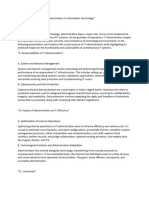Modbus: Modbus Is A Serial Communications Protocol Published by Modicon in 1979 For Use With
Uploaded by
Sahil BajajModbus: Modbus Is A Serial Communications Protocol Published by Modicon in 1979 For Use With
Uploaded by
Sahil BajajMODBUS
Modbus is a serial communications protocol published by Modicon in 1979 for use with its programmable logic controllers (PLCs). Simple and robust, it has since become one of the de facto standard communications protocols in the industry, and it is now amongst the most commonly available means of connecting industrial electronic devices. The main reasons for the extensive use of Modbus in the industrial environment are:
It has been developed with industrial applications in mind It is openly published and royalty-free It is easy to deploy and maintain It moves raw bits or words without placing many restrictions on vendors
Modbus allows for communication between many (approximately 240) devices connected to the same network, for example a system that measures temperature and humidity and communicates the results to a computer. Modbus is often used to connect a supervisory computer with a remote terminal unit (RTU) in supervisory control and data acquisition (SCADA) systems. Many of the data types are named from its use in driving relays: a single-bit physical output is called a coil, and a single-bit physical input is called a discrete input or a contact.
Limitations of MODBUS
Since Modbus was designed in the late 1970s to communicate to programmable logic controllers, the number of data types is limited to those understood by PLCs at the time. Large binary objects are not supported. No standard way exists for a node to find the description of a data object, for example, to determine if a register value represents a temperature between 30 and 175 degrees. Since Modbus is a master/slave protocol, there is no way for a field device to "report by exception" (except over Ethernet TCP/IP, called open-mbus)- the master node must routinely poll each field device, and look for changes in the data. This consumes bandwidth and network time in applications where bandwidth may be expensive, such as over a low-bit-rate radio link. Modbus is restricted to addressing 247 devices on one data link, which limits the number of field devices that may be connected to a master station (once again Ethernet TCP/IP proving the exception). Modbus transmissions must be contiguous which limits the types of remote communications devices to those that can buffer data to avoid gaps in the transmission. Modbus protocol provides no security against unauthorized commands or interception of data.
You might also like
- ESP32 Programming for the Internet of Things: JavaScript, AJAX, MQTT and WebSockets SolutionsFrom EverandESP32 Programming for the Internet of Things: JavaScript, AJAX, MQTT and WebSockets Solutions5/5 (2)
- Introduction To Mod Bus Protocol: BY S.Sandhya 1703099No ratings yetIntroduction To Mod Bus Protocol: BY S.Sandhya 17030999 pages
- What Is Modbus - Industrial IoT Data PlatformNo ratings yetWhat Is Modbus - Industrial IoT Data Platform8 pages
- Using MODBUS For Process Control and Automation PDFNo ratings yetUsing MODBUS For Process Control and Automation PDF7 pages
- Module 2 - Industrial Network ProtocolsNo ratings yetModule 2 - Industrial Network Protocols43 pages
- Modbus TCP Is A Communication Protocol Used Within Industrial Automation Systems For Transmitting Data Over Ethernet NetworksNo ratings yetModbus TCP Is A Communication Protocol Used Within Industrial Automation Systems For Transmitting Data Over Ethernet Networks2 pages
- electrical-engineering-portal.com-Using_MODBUS_for_Process_Control_and_Automation_1No ratings yetelectrical-engineering-portal.com-Using_MODBUS_for_Process_Control_and_Automation_13 pages
- Modbus FAQ: About The Modbus OrganizationNo ratings yetModbus FAQ: About The Modbus Organization4 pages
- Modbus and Wireless HART Protocol's ComparisonNo ratings yetModbus and Wireless HART Protocol's Comparison3 pages
- Communication Methods (Protocols, Format & Language) For The Substation Automation & Control by MUHAMMAD UZAIR (Project Report of Course 586 B)No ratings yetCommunication Methods (Protocols, Format & Language) For The Substation Automation & Control by MUHAMMAD UZAIR (Project Report of Course 586 B)10 pages
- Instrumentation Standard Protocols: Industrial Automation Unit 2No ratings yetInstrumentation Standard Protocols: Industrial Automation Unit 222 pages
- Scada Protocols and Communication Trends: by Rao KalapatapuNo ratings yetScada Protocols and Communication Trends: by Rao Kalapatapu11 pages
- Introduction To Bus Protocols of Mod Industrial Ethernet: BY S.Sandhya 1703099No ratings yetIntroduction To Bus Protocols of Mod Industrial Ethernet: BY S.Sandhya 17030999 pages
- Development of A Data Acquisition and Monitoring System Based On MODBUS RTU Communication ProtocolNo ratings yetDevelopment of A Data Acquisition and Monitoring System Based On MODBUS RTU Communication Protocol8 pages
- Unit Iv Introduction To PLC ProgrammingNo ratings yetUnit Iv Introduction To PLC Programming13 pages
- Using MODBUS For Process Control and AutomationNo ratings yetUsing MODBUS For Process Control and Automation1 page
- Introduction To Modbus - National InstrumentsNo ratings yetIntroduction To Modbus - National Instruments7 pages
- Industrial Protocols and Westermo Devices CompatibilityNo ratings yetIndustrial Protocols and Westermo Devices Compatibility12 pages
- Computer Networking: An introductory guide for complete beginners: Computer Networking, #1From EverandComputer Networking: An introductory guide for complete beginners: Computer Networking, #14.5/5 (2)
- Introduction to Internet & Web Technology: Internet & Web TechnologyFrom EverandIntroduction to Internet & Web Technology: Internet & Web TechnologyNo ratings yet
- Sub: REPLY TO EXAMINATION REPORT (MIS-R) Dated On: 18/05/2018 16:17:42 Ref: Application Number: 3811116No ratings yetSub: REPLY TO EXAMINATION REPORT (MIS-R) Dated On: 18/05/2018 16:17:42 Ref: Application Number: 381111618 pages
- 5G NR Standard Evolution 3GPP RAN1 UpdateNo ratings yet5G NR Standard Evolution 3GPP RAN1 Update36 pages
- Question Paper For Chapter 1 Irrational NumbersNo ratings yetQuestion Paper For Chapter 1 Irrational Numbers5 pages
- Infoblox Deployment Guide Network Insight Deployment GuideNo ratings yetInfoblox Deployment Guide Network Insight Deployment Guide38 pages
- Waygate Technologies: Version 01.26.B3 Fixes and EnhancementsNo ratings yetWaygate Technologies: Version 01.26.B3 Fixes and Enhancements6 pages
- ATTaCKing Threat Management A Structured Methodology For Cyber Threat AnalysisNo ratings yetATTaCKing Threat Management A Structured Methodology For Cyber Threat Analysis30 pages
- Stack, Queue, Recursion and Bit Manipulation PDFNo ratings yetStack, Queue, Recursion and Bit Manipulation PDF9 pages
- Exploring Chatbot Development Using Python A Final Year Computer Science ProjectNo ratings yetExploring Chatbot Development Using Python A Final Year Computer Science Project2 pages
- Nc1590 - Introduction To Systems Development l2 p1 Memo Supp 2019No ratings yetNc1590 - Introduction To Systems Development l2 p1 Memo Supp 20195 pages

























































































